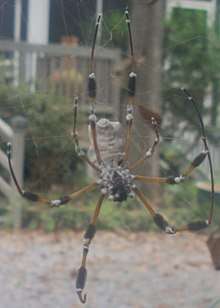Muscardine
Muscardine is a disease of insects. It is caused by many species of entomopathogenic fungus. Many muscardines are known for affecting silkworms.[1] Muscardine may also be called calcino.[2]
.jpg)
While studying muscardine in silkworms in the 19th century, Agostino Bassi found that the causal agent was a fungus. This was the first demonstration of the germ theory of disease, the first time a microorganism was recognized as an animal pathogen.[3]
There are many types of muscardine. They are often named for the color of the conidial layer each fungus leaves on its host.[1]
Black muscardine
Black muscardine is caused by Beauveria brongniartti and Metarhizium anisopliae.[1]
Metarhizium species such as M. anisopliae can cause fatal disease in over 200 species of insect.[4]
Brown muscardine
Aspergillosis of insects can be called brown muscardine. Over 10 Aspergillus species can cause the disease, such as A. flavus and A. tamari. The conidial layer may be brownish or greenish yellow.[1]
Grassy muscardine
Grassy muscardine is caused by Hirsutella necatrix.[5] This fungus produces an enzyme that breaks down the chitin in its host's body.[6]
Gray muscardine
Gray muscardine is caused by Isaria javanica.[5]
Green muscardine
Green muscardine is caused by Nomuraea rileyi as well as Metarhizium species. Keepers of silkworms recognize symptoms such as dark brownish lesions with lighter centers on the sides and back of the larva. At death the larva turns white and within a few days it is covered in a bright green fungal coating.[2]
Orange muscardine
Orange muscardine is caused by Sterigmatocystis japonica.[1]
Penicillosis
Penicillosis of insects is considered a type of muscardine, particularly when caused by Penicillum citrinum and P. granulatum.[1]
White muscardine
One of the best known forms is white muscardine, which is caused by Beauveria bassiana.[7]
When suffering from white muscardine, an insect larva may become inactive and stop eating. The elasticity of its cuticle is lost and it may experience vomiting and diarrhea. As it dies it hardens.[1] The fungus leaves the body of its host covered in powdery white conidia.[7] The fungal layer is tough due to oxalate crystals, and this slows the decay of the body.[1] When a pupa is infected, it often mummifies. It shrinks and wrinkles before growing a fungal coating. In an adult moth, the body hardens and the wings drop off.[2]

During infection, the fungus absorbs water and nutrients from the host. The hemolymph of the insect crystallizes and thickens. The fungus usually produces toxins, as well. After it kills the host, the fungus continues to absorb water from the body, causing it to harden further.[2]
Other insects prone to white muscardine include the brown planthopper[7] and the diaprepes root weevil.[8]
Yellow red muscardine
Yellow red muscardine is caused by Isaria fumosoroseus. It can produce reddish patches on the external body and powdery masses of spores internally.[1]
Control
Fungicidal agents such as azadirachtin and phytoallexin have been used against some muscardine pathogens.[9] Silkworm breeders dust their cages with slaked lime to discourage fungal growth.[10] In India a dust of chaff soaked in formalin is applied to the larvae.[11]
References
- Singh, T. Principles And Techniques Of Silkworm Seed Production. Discovery Publishing House. 2004. pg. 277.
- Lu, Y. Silkworm Diseases. FAO. 1991. pg. 37.
- Mahr, S. Know Your Friends: The Entomopathogen Beauveria bassiana. Midwest Biological Control News October, 1997. Volume IV, Number 10.
- Wang, C. and Y. Xia. Cover photo. PLoS Genetics, January, 2011.
- Vega, F. E. and H. K. Kaya. Insect Pathology. Academic Press. 2012. pg. 433.
- Chernin, L., et al. (1997). Chitinolytic activity of the acaropathogenic fungi Hirsutella thompsonii and Hirsutella necatrix. Canadian Journal of Microbiology 43(5) 440-46.
- White Muscardine Fungus. Archived 2013-07-04 at Archive.today Rice Knowledge Bank. International Rice Research Institute (IRRI). 2009.
- Beavers, J. B., et al. (1972). Two Muscardine fungi pathogenic to Diaprepes abbreviatus. The Florida Entomologist 55(2) 117-120.
- Vyas, R. V., et al. (1992). Effect of some natural pesticides on entomogenous muscardine fungi. Indian J Exp Biol. 30(5) 435-6.
- Ravikumar, J., et al. Muscardine: a menace to silkworm in winter. The Hindu. January 7, 2010.
- Veeranna, G., et al. (1985). Muscardine Disease – Precautionary Measures and Its Control. Karnataka State Sericulture Research and Development Institute, Bangalore, Karnataka.